Glass Manufacturers’ Marks (logos, trademarks, markings, emblems, signatures) seen on antique and vintage bottles, fruit jars, insulators, tableware and other types of glassware, C through D listings ~ Please Note: for introductory and explanatory comments and discussion concerning this alphabetical mark listings section of the website, please click on the “A-B” link below which points to “page one”. Thank you!
[ A – B ] [ C – D ] [ E – L ] [ M – R ] [ S – Z ]
- C……………….. On containers, sometimes this might be simply a mold identifier, but in many cases the letter probably stands for a specific glass company. A capital letter “C” is seen on the bottom of quite a few older handmade bottles of various types (that generally date from the c. 1870s-1890s) and there is no conclusive evidence to indicate exactly who made them. One fairly strong possibility is Cunningham & Company of Pittsburgh (see C & Co marks on this page). Other possibilities include Clyde Glass Works, Clyde, New York; Canton Glass Company, Canton, Ohio; and Cohansey Glass Mfg. Company, Bridgeton, New Jersey. See this article by Bill Lockhart and the Bottle Research Group (pages 621-623) in which some “C” bottles are discussed: https://sha.org/bottle/pdffiles/Cunningham.pdf I have been told (by longtime bottle digger and collector Dave Beeler) that a lot of bottles of various kinds with just a “C” on the bottom have been dug in the St. Louis, MO area over the years, and he believes the mark may stand for John K. Cummings (proprietor of the St. Louis Glass Works for a number of years) – Cummings was involved with that factory beginning in 1861 and lasting until its apparent closure in 1888. Although I can’t say whether Dave is correct or not, he certainly brings up an interesting question. Several notable bottles are found with a “C” on them. Just three examples: The GIX-25 type scroll or violin flask (found in a number of colors including aquas and greens) bears the letter “C” on the front. The scroll flask type is generally of Midwestern origin. Some collectors believe this particular flask originated from Pittsburgh (in particular, Cunningham’s glass works). Another pictorial flask, lettered “The Great Western” across the front, and catalogued as GX-30 (in McKearin’s historical flask charts) is marked with a “C” on the base. It’s provenance is unknown, although believed to date from sometime in the 1865-1875 period. Note: there was a glass factory in St. Louis, c. 1856 named “Western Glass Company” that failed after a short time, and also a much later, unrelated glassworks named “Great Western Glass Works” (1874-c.1887). A clear nursing bottle marked “St. L. G. W.” across the front (the lettering probably standing for St. Louis Glass Works) is marked with a “C” on the base. Whether there is any connection between those three bottles is unknown.
- C (highly stylized emblem seen on upscale tableware including tumblers)…………. this particular mark is actually an “R” but might be mistaken as an abstract capital “C” or “G”. Please see the “R” entry (on page four) showing an actual photograph of this mark used by Rosendahl, Copenhagen, Denmark.
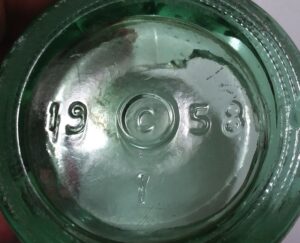
“C in a circle” on base shard of Coca-Cola bottle made by Chattanooga Glass Company in 1958. - C in a circle……………Chattanooga Glass Company, Chattanooga, Tennessee & other plant locations in later years (1901-1988), this mark was used c.1927-1988. The circle reportedly may be either “single line” or “double line” on some earlier bottles. Chattanooga Glass Company made tremendous quantities of the classic “hobbleskirt” shaped Coca-Cola bottles, and the “C in a circle” is often seen on the side or the base of these bottles, as well as on lots of soda bottles from other firms. Also see “C B G CO”, “CHATT”, “CGC” and “C inside a diamond”.
- C inside a diamond………………….Chattanooga Bottle & Glass Manufacturing Company, Chattanooga, Tennessee (mark possibly used c.1901 – c.1913). See also “C.B.G.Co.” “CHATT” and “C in a circle”.
- C in a pentagon…….Unknown. Seen on base of glass figurines.
- C in a rectangle…………Crystal Glass Company, Los Angeles, California (c. 1921-1928).

“C inside rectangle” mark (Photo courtesy of Darlu Littledeer) Although Julian Toulouse illustrates this mark as (apparently) a “C in a square” in his BOTTLE MAKERS AND THEIR MARKS (1971), the original reference which he alludes to is Arthur G. Peterson’s 400 TRADEMARKS ON GLASS(1968) and the shape in Peterson’s book, page 48, is described as a “rectangle”. The Crystal Glass Company, according to Toulouse (he referring to contemporary glass manufacturer directory listings) made glass tableware, both pressed and blown. I’ve received photos showing this mark, obviously a “C within a rectangle”, clearly embossed on the base of a heavy, clear glass water pitcher which appears to be of early 20th century make, in a design somewhat akin to EAPG patterns such as FLUTE, HUBER, COLONIAL, HEAVY RIB, or some variant of that general type of pattern. I am assuming this pitcher was indeed made by Crystal Glass Company of Los Angeles.
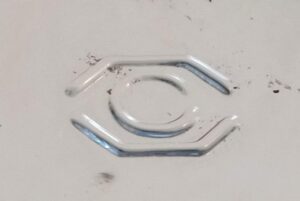
“C inside horizontally divided hexagon” mark used by Vidriera De Castilla, Guadalajara, Spain (Photo courtesy of Alex W) - C inside horizontally divided hexagon (shown) …………………. Vidriera de Castilla, S.A., Azuqueca de Henares, Guadalajara, Spain. This mark was illustrated on page 597 of Bottle Makers and their Marks (Julian Toulouse, 1971), but I don’t have an exact timeline on it’s use. I presume it was used in the 1960s – 1980s and possibly later?
- C within a horizontal rectangle (as seen on the bottom of green glass dispenser jars made for insect sprayers)……… unidentified, but likely the initial of the company that marketed the sprayers. This marking has no connection with the Crystal Glass Company above. The sprayer jars may also carry the “R inside a triangle” mark which identifies them as a product of Reed Glass Company of Rochester, New York.
- C in a star………………………Coshocton Glass Company, Coshocton, Ohio (c. 1902-1921). This company was known for making large numbers of beer bottles. Their bottles were more commonly marked with the “C G CO” initials on the heel. Also, see next entry.
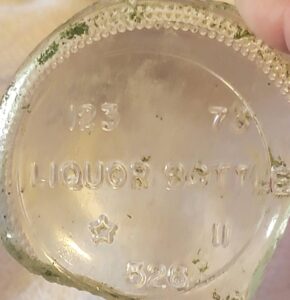
Base of clear bottle made by Star City Glass Company. This bottle would probably be from the Coventry, Rhode Island plant. The piece bears the diagnostic “123” liquor bottle permit code number, and a date code for 1973. The “C” is not clearly shown inside the star. (Photo courtesy of Jodi Gerstenhaber). - C in a star………………….. a similar mark may be found on bottles made by the Star City Glass Works, Star City, West Virginia (1948-1966) and Coventry, Rhode Island (1966-c. 1976). Sometimes the “C” may not be clearly visible. This company made lots of liquor bottles. The star marking has been confirmed on the bottom of bottles that also bear the liquor bottle permit number “123”. These are all machine-made bottles.

“C inside a triangle” mark used by Consumers Glass Company, Montreal, Canada - C in a triangle…………………………….Consumers Glass Company, Ville St. Pierre, Montreal, Quebec, Canada (1917-2002). Mark was an inverted triangle (point down) from 1917 to 1961, and a slightly rounded “right-side up” triangle after 1962 (shown in pic, above), according to information per Toulouse. Consumers Glass (division of Consumers Packaging, Inc) was acquired by Owens-Illinois, Inc. (O-I) in 2002 and is now known as O-I Canada. I am assuming (but do not know this to be true) that all bottles produced after O-I acquired Consumers Glass are marked with the Owens-Illinois identification (i.e. “I inside an O” or “O-I”) and the “C in a triangle with rounded corners” logo has been discontinued.
- C in a triangle…………………………Cambridge Glass Company, Cambridge, Ohio (1901-1958). Cambridge Glass produced high-quality, handmade pressed and blown tableware, art glass and novelties, NOT utilitarian container glass. Their “C in a triangle” trademark was used between about 1922 and 1937, but only on some items, as much of their glass was not marked. Usually the triangle is oriented “right side up” (with the “flat” side down), but when viewing some transparent items from the top of the piece, the mark might then appear with the C placed inside an “inverted triangle” (pointing up). For more info please see this page with a brief history of the company, from the National Cambridge Collectors, Inc. website: http://cambridgeglass.org/articles/cambridgehistory.php
- C with NY inside……………………..Central New York Bottle Company, Auburn, New York (c. 1978-1994). In 1994, Central was purchased by Owens-Illinois, to become their plant #35, which is still in operation as of 2016. See “NY within a C” entry on page four.
- Caldwell’s (“Dr. W. B. Caldwell’s / Monticello, Illinois” or “Caldwell’s Syrup Pepsin”) …………………. Patent medicine bottles found in many, many variants, with slight differences in exact wording or arrangement of lettering. Please see this page for more information .
- California (embossed on electrical insulators) ………………………….California Glass Insulator Company/ California Glass Works, Long Beach, CA (1912-1914)
ADVERTISEMENT
- Camden Glass Works…………Camden Glass Works, Camden, New Jersey (1875-1884).
- Canton………………………….Canton Glass Company, Canton, Ohio (1883-1890), Marion, IN (1890-1958) and Hartford City, IN (1958-1991+). Fruit jars embossed “The Canton Jar”, “The Canton Fruit Jar” or a similar embossing are products of this company. Those jars date from the earlier years of the company, i.e., in the 1880s & 1890s. Canton is also known for having produced tableware in a variety of patterns which are sought after by some EAPG (Early American Pattern Glass) collectors. Canton joined the National Glass Company combine and operated under that umbrella company from 1899 to 1902. In September 1902, a new firm under the name of “Canton Glass Company” was organized, and a new factory building was erected in Marion right across the street from the old. After 1902, most of Canton’s glass production consisted of non-bottle, non-jar items including tableware and a large variety of other types of specialty glass such as lantern globes, bird baths and seed cups, sidewalk and skylight glass, hospital & laboratory glassware, bar & soda fountain glassware, etc. Canton moved to Hartford City in 1958, and was reportedly still in business there as late as 1991. It is unclear exactly how much and what types of glassware were being produced during this later period.
- CAPITAL (as seen on base of clear prescription bottles)……………. Fairmount Glass Works, Indianapolis, Indiana. This was the brand name given to a line of rectangular prescription bottles made by Fairmount. The type was termed their “Capital Oval” and made in a variety of sizes. An illustration of the “CAPITAL” marking on the base is shown in an undated bottle catalog issued by Fairmount, probably dating from the early to mid 1920s.
- Capstan logo (looks somewhat like “pawn” chess piece, shown above)…………….see Capstan Glass Company page.
- Carson, Warren & Co. Glasgow / Manufacturers……………….. please see “C. W. & Co.” entry, below.
- Carter’s …………………….Carter’s Ink Company, Cambridge, Massachusetts. Seen embossed on the base of ink bottles. For instance, a commonly seen type of “cone ink” style bottle is marked “CARTER’S / 1897 / MADE / IN. U.S.A.” on the bottom. This type of bottle was produced in large numbers and likely was made for a number of years after 1897, perhaps into the 1910s. The earlier versions are most often found in aqua, later ones are commonly clear glass. Actual glassmaker is uncertain on the earlier cone inks, but likely several different bottle manufacturers made these ink containers over a period of several decades. Some of the later versions may carry a glassmaker’s mark. For more info on the Carter’s Ink Company, check out https://en.wikipedia.org/wiki/Carter’s_Ink_Company .
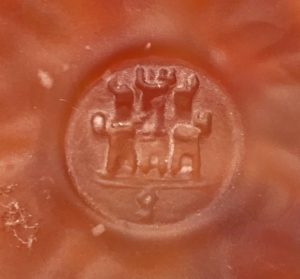
Castle logo used by Gibraltar Crystal (Photo courtesy of Myles Yaksich) - Castle (with key below)………………………….Gibraltar Crystal, Gibraltar (1995-2019). This company produced a lot of beautiful multi-colored handmade glassware including many types of vases and stemware. According to information posted recently on the internet, this firm closed permanently in August of 2019. The mark is stamped into the base of pieces. In some cases this mark is rather crudely drawn and thus it might be difficult to recognize what it’s supposed to represent. The figure below the castle may be mistakenly thought to be a lower-case letter “g”, and although it does bear a resemblance to that letter, it is meant to be the representation of a Key.
- Castoria, Fletchers (or Pitcher’s) ………………………….please see page on Fletcher’s Castoria.
- C B (on the base of colorful handmade glass items such as bottles, flasks, pitchers, bowls, etc) …………………….. Clevenger Brothers Glass Works, Clayton, New Jersey (1930-1999). Clevenger Brothers specialized in producing handblown flasks and other glassware made in the tradition of the early glass factories of New Jersey. Some examples can be very difficult to distinguish from the originals, although there are always subtle differences upon close examination, especially concerning the exact appearance of the base pontil mark. Most of their earlier bottles and flasks were unmarked, although a few pieces were marked with a small “CB” on the bottom, beginning in 1955. After 1966, all of their glassware was marked with “C B” although the lettering is typically larger and bolder. For some good info on Clevenger Bros. and how to tell some of their repro ware from older items, such as the “Fislerville Glass Works” Jenny Lind flasks and the cabin-shaped “Booz” whiskey bottles, check out this webpage: https://www.realorrepro.com/article/Have-you-been-fooled-by-the-Clevengers%3F
- C B (on base of light green handmade pickle or Chow-chow bottle from England, circa 1860-1910)………. unidentified with certainty, but possibly stands for Crosse & Blackwell. (See next two entries).
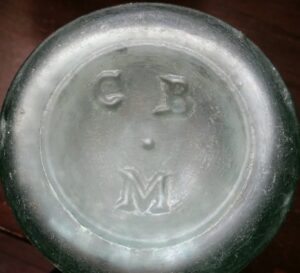
C B / M mark on base of antique light green glass pickle or chow chow bottle made in Great Britain - C B / B; C B / K; C B / M; C B / D&M (as shown, with letters arranged in a triangular formation)……………………uncertain meaning, but the “C B” probably stands for Crosse & Blackwell, a food distributing company in London, England dating from 1830. These markings are seen on the bases of various handmade, light green, wide-mouth round cylindrical pickle or “Chow Chow” food jars made in England that appear to date from the 1860s-1910s time period. They tend to be rather heavy, thick and somewhat crudely made with rolled or “square band” applied lips. At least some of these jars were evidently made by Kilner Bros., but other glass factories in England also made some of them, including Davey & Moore. Please see this page with more on these marks.
- C & B………………… probably Crosse & Blackwell. These initials have been confirmed on the lower side of a light green handblown cylindrical pickle bottle or “Chow Chow” food bottle that looks exactly like the bottles described above that bear “C B / M” or similar lettering on their bases (see above entry). The “C & B” mark has also been verified on the bottom of an applied-lip ale or beer bottle (made from a 3-piece mold) which appears to date from the 1870-1900 time period. That bottle, in sun-colored amethyst, was found recently in a secluded high desert setting in the southwest. Julian Toulouse (BM&TM, 1971, page 114) stated that containers made for Crosse & Blackwell were made by a number of glass companies in Great Britain including Davey & Moore; Cannington Shaw & Company; Kilner Bros. Glass Co; Kilner Bros, Ltd; Bagley & Company; John Kilner & Son; Edgar Breffit & Co., and Redfearns Glass.
- C.B.CO………………Charles Boldt [Glass] Company, Cincinnati, Ohio (1900-1919). See also “B with 2 serifs” “Boldt Glass Co.” and “Boldt” entries. For much more detailed info on this company, see this webpage article (pdf file) written by researcher Bill Lockhart: https://sha.org/bottle/pdffiles/CharlesBoldt.pdf
- C.B. & Co / N ……………..almost certainly Charles Borron & Company, Newton-le-Willows, Lancashire, England (1866-1898?). This mark is seen on the bases of dark olive green ale/beer bottles which appear to have been made sometime in the 1870s-1910 period. It is unclear how late this company continued to operate. An old illustration showing this glassworks appears here on the www.newton-le-willows.com website. The operation was evidently quite large assuming the picture was reasonably accurate in its depiction of the works. Also, please see my page on the CBM / CBK / CBB pickle bottles and the entry on the “C & B” mark, above.
- C.B.G.CO…………….Chattanooga Bottle and Glass Manufacturing Company (later Chattanooga Glass Company), Chattanooga, Tennessee (mark used c.1901-c. 1927?). I had also seen a reference to a bottle (or bottles) marked “C.B. & G. CO.” (note the ‘&’) on the bottom, but have lost track of where or when I heard of it several years ago. If anyone knows of a bottle with this latter marking and can confirm its existence with more info and a photo, I would be grateful for your assistance. Also, see “CHATT” and “C in a circle” entries. “C inside a circle” is Chattanooga’s most well-known mark that was used from around 1927 to 1988 on tremendous numbers of bottles, especially sodas such as Coke.
- C. B. & G. Co………….I have doubts this mark actually exists. Please see above entry.
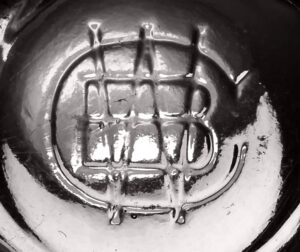
CBW mark on base of possible food bottle or jar with ten fluted/paneled sides. - CBW monogram (uncertain on intended order of letters, could be BCW, WBC, WCB, BWC or CWB)………… currently unidentified (photo above). This monogram seen embossed on a base shard from a ten-sided (fluted) food or condiment bottle or jar in clear glass (very slightly sun-colored amethyst). This letter combination is “common” and has likely been used on bottles made for a number of different bottling companies, breweries and dairies bearing those initials from around the country, but this does not appear to have been from either a soda, beer or milk bottle. Found in Louisville, KY area excavation site. Identification sought!
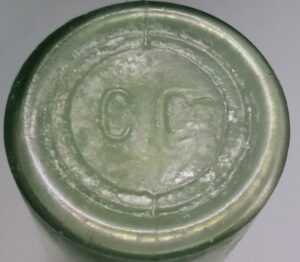
“C C” on base of green glass pickle jar/bottle, circa 1870s-1900 and probably from Great Britain. - C.C. (seen on the base of a mouthblown cylindrical pickle or “Chow chow” jar, in a light/medium green-colored glass that is very characteristic of British food bottles of that time period – c. 1870s – c.1900) …………………Uncertain meaning. The jar in question is almost identical to the “C B / M” jars described on this page, and almost certainly is a product of England – not an American-made container.
- C. CO………………Cunningham(s) and Company, Pittsburgh, Pennsylvania (c.1879-1907)
- C & C LIM………Cunningham(s) and Company, Limited, Pittsburgh, Pennsylvania (1886-1907)
- C & CO……………Cunningham(s) and Company, Pittsburgh, PA (c.1879-1907)
- C & CO LIM……..Cunningham(s) and Company, Limited, Pittsburgh, PA (1886-1907)
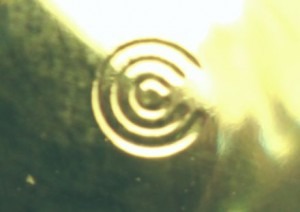
Continental Can Company ~ “3 C concentric C’s” mark on base of “Optic Dot” juice glass - CCC (3 C’s nested inside each other, see pic)……….Continental Can Company. Mostly seen on tableware, especially on the bases of drinking glasses (juice glasses, tea glasses, tumblers). Continental Can Company, a producer of several types of packaging, took over the Hazel Atlas Glass Company in 1957. Continental sold most of the H-A plants in 1964. It is unclear exactly what years the “CCC” mark was used on glassware, but it is clear that at least some of the new molds made for glassware during the period of 1957-1964 were engraved with the CCC mark instead of the H-A mark. The mark is frequently seen on the bottom of glassware in the popular pattern “Optic Dot”, sometimes called “Thumbprint”.
- CCCC (stylized monogram as shown)…………… Colonial Candle Company of Cape Cod, originally started in 1909 by schoolteacher Mabel Kimball Baker and based in Hyannis, Massachusetts. The company specialized in candles and related items. In 2012 the business headquarters was moved to Charleston, South Carolina. Photo is of the mark as seen on the base of small cobalt blue glass bowls or candleholders. The box they were packed in is marked “Made in England”. The glass company or companies that actually manufactured these and other items found with the mark is uncertain, but possibly unidentified glass makers located in Asia as well as Europe. This mark may date only from the later years of the company, perhaps after circa 1990 (?) If you have more detailed, accurate info on this company and the years they have used this mark, please write and I will give credit to contributor!
- C C & Co (monogram)……….Carl Conrad & Company, St. Louis, Missouri. Carl Conrad was a distributor of beer bottles made for Anheuser-Busch Brewing Company. Conrad was not an actual glass company. Best guess for the time period during which bottles were made with this base marking would be from about 1876 to 1885. Most were made in a distinctive pale blue-aqua glass. Some of these bottles also carry side embossing including the brand name “Budweiser”, although many are unembossed except for the C C & Co basemark. Some specimens carry a glassmaker mark as well (such as D.O.C.— D. O. Cunningham Glass Co., Pittsburgh) but many of these bottles without a glassmaker ID were probably made by one of several local St. Louis-area glass factories, such as Lindell Glass Company, Mississippi Glass Company, Belleville Glass Company, or Illinois Glass Company. (Adolphus Busch Glass Manufacturing Company did not come into existence until 1886, at which time the Belleville Glass Company was purchased by Adolphus Busch).

C.C.G.Co. amber beer bottle base shard, Cream City Glass Company, Milwaukee, WI (photo courtesy of Ansen Seale) - C. C. G. Co. …………………. Cream City Glass Company, Milwaukee, Wisconsin (1886-1892). Although most bottles with this mark are beer bottles made at Milwaukee, on a few bottles found in the West the initials could stand for Colorado City Glass Company, Colorado City, Colorado (1889-1893)
- C Co 2 MILW………….Chase Valley Glass Company, Milwaukee, Wisconsin (1880-1881). Occasionally seen on bases of cylindrical utility bottles. For more information and photos of bottles and marks used by this and several closely related companies in Milwaukee, please see this webpage: Wisconsin Glass Gallery on MrBottles.com website
- C. C. S. G. Co. (may be interpreted as “C. G. S. G. CO.”…………………………………. initials seen on the base of a square “schoolhouse” or carmine style ink bottle, first reported to me by digger and bottle collector Dave Beeler (shown below). Update [4-12-2025]: from recent research by the BRG (Bottle Research Group) – especially Bob Brown and Bill Lockhart, this marking has been found to stand for the C.C. Stutts Glass Company based in New York City, NY (c. 1897-c. 1915). The concern was evidently a bottle jobber, not an actual manufacturer. The square bottles found with these initials, although of the standard “schoolhouse ink” shape, have been found primarily within the context of pyrography (wood-burning) kits – a popular pastime in the very late 1890s and early twentieth century – the bottles being used to contain benzene. No other types of bottles bearing these initials have been confirmed to date, although C.C. Stutts advertised a wide variety of bottles (including honey bottles) and other types of glass including tumblers and tableware. They apparently had business arrangements to sell the product of a number of glassmakers including Agnew & Co. (Pittsburgh PA), George Jonas Glass Co (Bridgeton, NJ) and others.
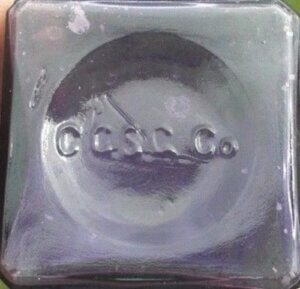
C.C.S.G.CO on base of schoolhouse carmine type ink bottle – used for benzene in pyrography kits – C.C. Stutts Glass Co., New York, NY. (Photo courtesy of Dave Beeler). - C C W (monogram)……… in some cases the “G G W” monogram (with the center letter somewhat larger than the other two) indicating Gayner Glass Works might be misread as CCW. Please check the “G G W” entry on Page Three.
- CD (logo that might be interpreted as two highly stylized cursive capital letters “C” and “D”, as seen on the bases of green and clear soda bottles………. please check my entry with photo of this mark , used 1988 to 1995, under “American National Can Company” on Page One.
- C & D (embossed on base of aqua pickle or condiment bottle)……………… Unidentified. The initials might stand for a glassmaker or a food distributer from Great Britain, possibly from the 1875-1900 time period. But this is only a guess!
- C.D. & P. T. CO. ……………..see next entry.
- C. D. & P. TEL. CO. (on glass telephone line insulators)………………Central District & Printing Telegraph Company, Pittsburgh, PA. This firm was organized in 1874, and lasted under that exact name until 1913, the name being changed slightly to Central District Telephone Company at that time. In 1918 it became part of the Bell Telephone Company of Pennsylvania. All insulators seen with this marking are of the CD 121 “toll” (long distance) style, most commonly seen in pale aqua glass, and generally appear to date from sometime within the 1895-1915 period. Most, if not all, were made by Brookfield Glass Company at their factory in Brooklyn, New York. (Also, see “C.& P. TEL.CO” entry).
ADVERTISEMENT
- Ceredo…………………….. Town name embossed within rectangular/oval frame on lower front of three historical “figured flasks” that date from the early 1860s. They were made in three sizes, listed as GXI-34, GXI-35 and GXI-36 (as catalogued in the McKearin system of historical flask identification) and were made in the small town of Ceredo, West Virginia, which is located along the Ohio River between Huntington, WV and Catlettsburg, KY. The flasks are lettered “FOR PIKE’S PEAK” with the figure of a “prospector” or traveler on one side, and the crude representation of an eagle on the other. (Several dozen different PIKES PEAK flask variants are known. They were made by a number of bottle factories, probably most of them located in the Midwest. Evidently the Pikes Peak flasks were produced throughout the 1860s with a few even into the early 1870s). Glass researcher and author Dean Six did research on this particular glass works, and found that there had indeed been a glass bottle factory that operated for awhile in the town of Ceredo. Six wrote an article concerning the Ceredo flasks (pages 6-7 in the May, 1996 issue of Antique Bottle & Glass Collector magazine). He found solid evidence that a glass factory had existed in Ceredo, blowing glass (a variety of bottles) from approximately October of 1860 into the summer of 1861. The Civil War evidently played a major role in the demise of the glassworks. One detail seems unclear so far: What was the exact name of the company or factory? It is presumed by collectors that the name was “Ceredo Glass Company” or “Ceredo Glass Works” but no one really knows for sure.
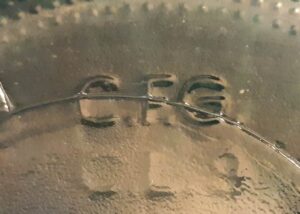
“C.F.G.” initials, as marked on the base of a green glass florist vase, standing for “Continental Floral Greens”. (Photo courtesy Shannon & Dawn Brown) - C. F. G. ………………. the CFG initials are seen on bases of green and clear glass floral containers such as vases and bowls. These containers are similar in general appearance to those marked “E. O. Brody & Co” and “Hoosier Glass”. and often show up on the resale market including thrift stores and garage sales. This mark was used by Continental Floral Greens, a company specializing in growing and shipping many types of plants for floral arrangements and cuttings. I recently sent an email to them, and received a reply that the company was not marking any glassware with those initials presently (2019). A webpage posted by www.wffsa.org includes this information: “Founded in 1954, the company grew to include Leatherleaf fields in Florida in the 1970’s. It expanded to offer a complete line of hard goods featuring CFG private molded glassware”. From this sentence I am assuming they are referring to glassware that was specifically made for them and was marked (embossed) with the CFG initials. From further research, this company, which was based in San Antonio, Texas, was acquired in 2014 by Great Day Group, LLC, of Sun Valley, Idaho, an investment firm. Evidently the glassware that bears this marking dates from the 1970s and/or 1980s, but I don’t have information that would give us a more precise date range for this glass. The actual manufacturer that produced the glass for CFG is currently unidentified, although I would not be surprised if it was made by well-known companies such as Anchor Hocking or Indiana Glass Company.
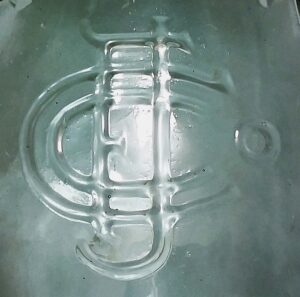
“C F J Co” monogram as it appears on the face of a MASON’S PATENT NOV 30TH 1858 Fruit jar. - CFJCo / C F J Co (letters entwined in monogram, shown at right, as seen on antique fruit jars, primarily MASON’S PATENT NOV 30TH 1858 and MASON’S IMPROVED types)……………. Consolidated Fruit Jar Company, New Brunswick, New Jersey with main business offices in New York City, New York (1871-c. 1885 or possibly later). Consolidated did not make their own jars, but had other glass companies make them with their logo. Consolidated was primarily a distributor. Factories that made jars for Consolidated included Clyde Glass Works, Whitney Glass Works, Illinois Glass Company and others. Some researchers believe the CFJCo logo was not actually marked on jars until April of 1878, that from information recorded in publications from the U.S. Patent & Trademark Office, but others think the logo may have been introduced on jars much earlier, possibly soon after the company was organized in 1871. I don’t think there is any solid proof that shows when the mark was first used on their fruit jars. There is also confusion on how late jars marked with that monogram were produced, some info suggesting the 1880s and other researchers indicating the 1908-1910 period. These jars are seen with a variety of base markings, usually consisting of a letter followed by a two or three-digit number. A few examples have been seen bearing a Christian cross along with the mold letter/number on the bottom. For more background info, check out Bill Lockhart’s detailed article here: https://sha.org/bottle/pdffiles/ConsolidatedFruitJar.pdf Note: there are also some modern reproduction fruit jars with this “CFJCo” monogram on them as well, so careful research is needed.
- C G atop a triangle (pointed “hill”)………… Columbine Glass Company, Denver, Colorado
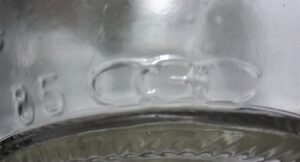
CGC mark on heel of clear soda bottle made by Container General Corporation in 1985. - CGC (monogram, letters horizontally entwined)…………………. Container General Corporation, Chattanooga, Tennessee (1983-1985). This was a short-lived merger of Chattanooga Glass Company (Chattanooga, TN) and Glass Containers Corporation (Fullerton, California).
- C. G. Co………………..This mark was evidently used by four (or more) different glass companies in the United States. Most bottles with this mark on the lower heel are believed to be products of the Coshocton Glass Company, Coshocton, OH (1902-1921), a prolific manufacturer of beer & soda bottles distributed widely but especially throughout the Midwest. Other possibilities include Canton Glass Company, Canton, OH (1883-1890) & Marion, Indiana (1890-1958) [See Canton] and Cohansey Glass Manufacturing Company, Bridgeton, NJ (c.1870-c.1900) and/or its successor Cohansey Glass Company, East Downingtown, PA (1900-1909). ALSO, please see the two following entries!
- C. G. Co…………….California Glass Company, California, Pennsylvania (c.1890s). Harvey Teal, a researcher and historian on South Carolina history, (author of a published book on the SC Dispensary flasks) reports that he has documents proving that some of the SC dispensary liquor flasks dating from the c.1893-1897 period marked “C.G.CO.” were definitely made by California Glass Co., although Phillip Kenneth Huggins (The South Carolina Dispensary-1997), attributed the marking to the Carolina Glass Company, Columbia, SC (1902- c. 1911). Apparently, both glass companies made the dispensary bottles AND used a C.G.CO. mark on them, although during different time periods. More information and discussion on the C.G.CO marks on South Carolina dispensary and other bottles can be found in this article by Bill Lockhart et al: https://sha.org/bottle/pdffiles/Cohansey.pdf
- C. G. Co. (on “POLAR BEAR” pattern glass bread tray) ……………… believed to be Crystal Glass Company, Bridgeport, Ohio (1883-1907). This particular Crystal Glass Company was started in c.1868 at Pittsburgh, and later moved to Bridgeport. The C.G.Co. initials which are known on the bread tray from approximately 1885 (and may be on other items in the “Polar Bear” pattern as well) were attributed to Crystal Glass Co. by Ruth Webb Lee in her groundbreaking reference work “Early American Pressed Glass” (1931 and later editions) from a personal conversation she had with an elderly knowledgeable Pittsburgh-area glassblower. Crystal Glass Company made mostly pressed glass tableware items (usually classed under “Early American Pattern Glass”, known to collectors as simply EAPG) and was not a producer of blown commercial containers, so this mark is virtually certain to be UNRELATED to the “C.G.Co.” seen commonly on beer bottles.
- C. G. I. Co. (embossed on glass telephone insulators)……………….California Glass Insulator Company/California Glass Works, Long Beach, CA (1912-1914) See this page for more information.
- C.G.M.CO…………..Campbell Glass Manufacturing Company, West Berkeley, California (1885). In some cases (especially bottles found in the eastern U.S.) the initials might stand for the Cohansey Glass Manufacturing Company, Bridgeton, NJ (c.1870-1900) or Cumberland Glass Manufacturing Company, Bridgeton, NJ (1880-1920).
- C.G.W……………..Campbell Glass Works, West Berkeley, California (1884-1885), on certain bottles known to be from California, especially the San Francisco area. This company is given as the source of the “C.G.W.” mark by Julian Toulouse (Bottle Makers and their Marks, 1971). Since it operated for less than four months, and Toulouse included no information on why he believes this mark can only be attributed to Campbell (other than the fact that the initials fit), I am very skeptical that all bottles with this mark originated from that company, especially bottles and flasks with this mark found in the East. Another possible source (in my opinion, which may be no better than Toulouse’s!) could be any one of several Eastern region glass companies, for instance Clyde Glass Works, Clyde, New York; Cumberland Glass Works/Cumberland Glass Mnfg. Co., Bridgeton, New Jersey; or Camden Glass Works, Camden, New Jersey (1875-1884). Also, see next entry.
- C G W (monogram on base of mouthblown aqua food jar, with center letter G larger than the other two letters)…………………….. this may be a case of misreading the “GGW monogram” – which is believed to stand for Gayner Glass Works – please check the G G W monogram entry on Page Three.
- C & H……………Coffin & Hay, Hammonton, New Jersey.
- CH (along the lower heel of soda bottles, preceded and followed by various numbers; embossing may be faint)…………Graham Glass Company, at their Checotah, Oklahoma bottle plant. See Graham.
- C H (C with an H inside)……………Cristalerias Cattorini Hermanos, Buenos Aires, Argentina, South America. (1952-to date). This mark is most frequently seen in the US on the base or heel of imported emerald green (“forest green”) beverage bottles, often marked “WATER” and/or “JUICE”. These containers were often saved and re-used as refrigerator bottles. I believe most, of not all, of those bottles were made in the 1960s or very early 1970s, but some may date later. The trademark is evidently still in use and appears on the Emhart punt marks database.
- C-H ……………………. Castle-Hanson Corporation, Rochester, New York (1959-circa 1970s??) . Castle-Hanson took over the former Reed Glass Company plant in Rochester (see “R in a triangle” mark) and operated through the 1960s and later. Castle-Hanson plant at Rochester was eventually purchased by/became part of Leone Industries, based in Bridgeton, New Jersey (see “L in an unconnected square” mark). Some ware with this “L” mark was made at Rochester as well as Bridgeton. Exact beginning and ending dates of Castle-Hanson and Leone Industries operations are unclear……anyone with solid info, please contact me!
- Chas. Boldt Co. Cin O. ……………Charles Boldt Company/ Chas Boldt Glass Company/Charles Boldt Glass Manufacturing Company, Cincinnati, OH (1900-1919) and Huntington, West Virginia (1900-1929). Seen on lower heel of a clear packer bottle, probably made for vinegar. Presumably this would date from the earlier time period at Cincinnati. Please see “Boldt”, “C.B.CO.” and “B with 2 serifs” marks.
- Chas. H. Fletcher’s / Castoria……………….. please see Fletcher’s Castoria page.
- CHATT. …………..Chattanooga Bottle & Glass Manufacturing Company (Chattanooga Glass Company), Chattanooga, Tennessee (1901-1988). Period of use of this particular Chattanooga mark is uncertain. I have personally seen it embossed on the base of an amber machine-made medicinal flask, and just by general appearance, I would estimate that it dated from sometime in the 1920s or 1930s. More detailed information on this mark would be appreciated.
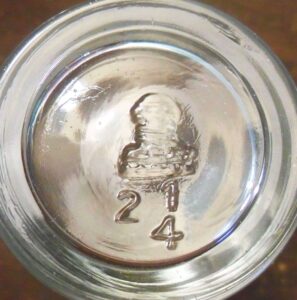
Capstan Glass Company mark on base of jelly glass. This is a ship Capstan, but often misidentified as a “Pawn” chess piece. - Chess piece (Pawn)…………..see Capstan Glass Company.
- C.H.B.CO…………………Chicago Heights Bottle Company, Chicago, Illinois (1912-1913). These initials are confirmed to exist on at least one bottle (info courtesy of Bill Lockhart) and are almost certainly that of the Chicago Heights concern. For another mark attributed to this short-lived company, see “SIGNET”.
- C.H.C & S…………………. unidentified. This mark, accompanied by a mold number, is seen on the base of dark green handmade British ale bottles. They appear to be typical of ales from the 1870s-1900 period. They have been reported to me by several readers. At the present time (4/2019) I am unaware what the marking stands for.
- Chesebrough / Manuf’g. Co. Cd. / New – York. This marking (or a similar variation) is seen embossed on many jars that held Vaseline (brand of petroleum jelly). See this page for more information.
- C and I intertwined (“C” and “I” monogram)………….. please see “I superimposed over a G” entry on page three. The IG monogram mark used on tableware made by Imperial Glass Company, Bellaire, Ohio, might be mistaken for an IC mark.
- C. IHMSEN & CO…………..Christian Ihmsen & Company, Pittsburgh, PA. (c. 1837-c.1855)
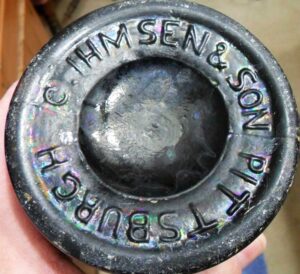
C. IHMSEN & SON – PITTSBURGH – on base of dark amber squat ale bottle. - C. IHMSEN & SON, PITTSBURGH …………….. Christian Ihmsen & Son, Pittsburgh, PA (c. 1855- c.1861 or possibly later). Embossed lettering is seen on the bottom of amber ale bottles and aqua wax sealer fruit jars. I think bottle and jar molds with both the “SON” and “SONS” lettering might have been in use simultaneously, at least for some limited period of time. Please see next entry.
- C. IHMSEN & SONS, PITTS. PA. …………. Christian Ihmsen & Sons, Pittsburgh, PA (c. 1855- c. 1875). The exact time period for the “proper” business names used by this and the preceding firm is unclear. Scroll flasks were made by “Christian Ihmsen & Sons” in 1856, as a number of flasks of this type were recovered from the ARABIA steamboat that sank in the Missouri River on September 5, 1856. The packing crate was lettered “Christian Ihmsen & Sons, Pittsburgh, PA”.
- C. I. & SONS………. Christian Ihmsen & Sons, Pittsburgh, PA. (c. 1855- c. 1875)
- C. & I…………Cunningham and Ihmsen, Pittsburgh, Pennsylvania (c. 1865- c. 1878)
- C. & I. Co……..Same as above.
- Circles (group of four circles or letter “O’s” connected as a monogram, as seen on the bottoms of mugs, tumblers and drinking glasses)………….. Libbey St. Clair, Canada. Please see entry under OOOO on Page Four.
- CL (C partially overlapping an L)………………….. Carr-Lowrey Glass Company, Baltimore, Maryland (1889-2003). Maker of a tremendous variety of druggist, medicine, perfume, cologne and other cosmetic containers, many in unusual, rich shades of color. Carr-Lowrey (often misspelled “Carr-Lowery”) was one of the makers of the Avon figural bottles, such as the car, boat and train engine bottles. The company was bought by Anchor Hocking Glass Company in 1944 but retained their own identity and mark. Because of stiff foreign competition and the increasing use of plastic for many products, the factory finally shut down production of glass bottles on June 6, 2003 and filed for bankruptcy shortly thereafter. For an interesting video showing automated glass bottle manufacturing on the very last day of production at Carr-Lowery, with an “inside view” of the factory and some of the hard-working employees working that day, you might check out this film: https://www.youtube.com/watch?v=59Ttwiyuig8 . Also see “C.L.G.CO.” entry.
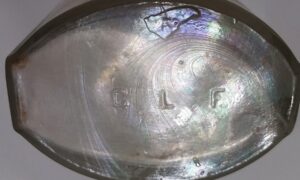
“C L F” on base of handblown druggist bottle made by C.L. Flaccus Glass Company. - C L F ……………………… C. L. Flaccus Glass Company, Pittsburgh, Pennsylvania (1879-c. 1927). This particular mark is uncommon but is embossed on the base of a small, clear, mouthblown strap-sided druggist/apothecary/prescription bottle that looks to date from the 1880s. The bottle is a “generic” style with no lettering on the front. See next 2 entries, also see “F in a keystone” mark.
- C. L. F. G. CO…………..Same as above. Occurs on the bases of South Carolina Dispensary bottles. See next entry.
- C. L. Flaccus / Pittsburgh……………….. C. L. Flaccus Glass Company, Pittsburgh, Pennsylvania (offices); manufacturing plants were located at Tarentum (their main plant) as well as Leechburg, Beaver Falls, New Brighton, California, and Charleroi, PA (1879-c. 1927). This particular mark seen on base of wax sealer fruit jar. For more background info on Flaccus, see this article by Bill Lockhart et al: https://sha.org/bottle/pdffiles/CLFlaccus.pdf
- C.L.G.CO………….Carr-Lowrey Glass Company, Baltimore, Maryland (1889-2003). Mark was used primarily before about 1920. Often misread as “C.L.C.CO”. Carr-Lowrey made many druggist, perfume and other cosmetic bottles in beautiful shades of color, including more “unusual” shades such as rich bright emerald green, teal green, teal blue, and turquoise. See “CL / C partially overlapping an L” entry.
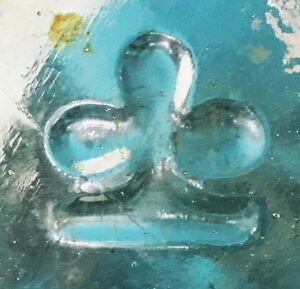
Clover-like logo seen on base of pharmacy bottle, made by Hermann Heye Glasfabrik, Germany (photo courtesy Lynne Wertz) - Clover-like symbol as seen on base of light aqua apothecary/pharmacy bottle, reported to me by Lynne Wertz who shared picture at right. This mark was used by Hermann Heye Glasfabrik, Obernkirchen, Germany (1843-to date), although that particular mark may date from around 1900 up to the 1970s. It has been seen on other types of containers including “Codd” type soda bottles. The logo is illustrated on page 579 of the original hardcover edition of Bottle Makers & Their Marks (Toulouse, 1971). For more detailed information on this and related marks, please see this article written by Bill Lockhart et al, on the Heye company: https://sha.org/bottle/pdffiles/HermannHeye.pdf
- Clyde…………………….Clyde Glass Works, Clyde, New York (c. 1868-1912). Also see “E Son & H” and “E S & H”.
- Clyde Glass Works……………….Clyde Glass Works, Clyde, New York (c. 1868-1912)
- C.MFG.C………….. Unknown (Seen on base of fruit jar, c.1870s).
- C MILW…………… See “C Co 2 MILW”.
- C NY…….. see “NY inside a C” entry on “page four.
- Co, inside abstract letter “O” or circle, perhaps a monogram for “O Co”? Unidentified/unknown. This mark appears on the base of a small, clear handmade bottle, c. 1890-1920, perhaps used for a perfume or cosmetic product. The general appearance of the mark vaguely reminds me of the cross-sectional diagram of an eye.
- C-O G Co………….Unknown. Reported on milk bottle, per Jeffrey Giarde (Glass Milk Bottles: Their Makers and Marks, 1980).
- Cohansey………………….. Cohansey Glass Manufacturing Company (c.1870-1900). Factory: Bridgeton, New Jersey. Business offices in Philadelphia, PA.
- COLO. C. G. CO…………..Colorado City Glass Company, Colorado City, CO (1889-1893)
- COLO. CITY G. CO……..Colorado City Glass Company, Colorado City, CO (1889-1893)
- COLO. G. W. ………..Colorado Glass Works Company, Golden, Colorado (1887-1888)
- Colo. G. W. Co…………same as above.
- Cooper & Wood / Portobello ………… Cooper & Wood, Portobello, Scotland (c. 1859-1866). (Portobello is now part of Edinburgh, Scotland). Seen on bases of black glass ale or wine bottles. On some bottles the lettering on the base may include the word “Manufacturers”. Many of these types of bottles were exported to the US, Australia and other countries. For more background information on this and several related glassworks, see this article: https://sha.org/bottle/pdffiles/Cooper&Wood.pdf
ADVERTISEMENT
- Country Store Products, U. S. A. / PAT. NO. D234,806 ……………… marking embossed on base of candle cup (votive candleholder or toothpick holder) with strongly embossed floral design. The design features may be intended to portray daisies or sunflowers and tulips. A “stemmed” version also exists which was awarded patent number D235,159. These were evidently made for that distributing company, which was owned/operated by Robert F. Ball and based in Warrington, Pennsylvania. The patent numbers were awarded (respectively) on April 8, 1975 and May 20, 1975. Presumably most of these cups date from that time period although the patent was to be in effect for 14 years. I don’t know of any evidence to show what glass manufacturer made these items. They might be products of an unidentified glassmaker here in the United States, or possibly they were made by a glass company in Asia (Taiwan or Hong Kong). They are found in several colors including amber, dark olive green, white milk glass, blue and clear. Other colors may be out there.
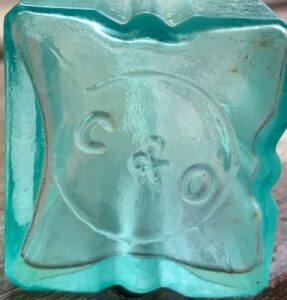
“C & O” on base of aqua pepper sauce bottle. (Photo courtesy of J. Thomas) - C & O (on base of aqua pepper sauce bottle, as shown in photo)…………………. Unknown. These initials appear on the base of an American-made, vertically ribbed pepper sauce bottle that probably dates from sometime in the 1865-1890 period. If you have information on the meaning of these initials, please contact me!
- C. & P. TEL. CO (on open-wire telephone line insulators)………………….. Chesapeake & Potomac Telephone Company. This marking is seen on the skirt of CD 121 type “toll” or long distance line insulators. C&P Tel Co. began in 1883 but eventually became part of the AT&T and Bell Telephone systems, now part of Verizon. The insulators probably date from sometime in the c.1895-1915 period and all were manufactured by Brookfield Glass Company. They are found in shades of aqua and green.
- C with an “R” inside (mark seen on clear bottle base that appears to date from the early or mid-1970s)……….. Unidentified meaning.
- C. R. …………….. probably either Curling Robinson & Company, Pittsburgh, PA (c. 1834-c.1861) or Curling, Ringwalt & Company, Pittsburgh, Pennsylvania (c.1856-1863?). “C R” (in “mirror image” embossed letters) is found marked on the bases of a number of “Cathedral” type pickle bottles from the steamboat Bertrand which had sunk in the Missouri River on April 1, 1865. The bottles could have been made months or even several years before they were actually filled with product and shipped. Both of these firms have been credited with making pattern glassware as well as common utility bottles. A directory listing has been found for Curling, Ringwalt & Company — on page 30 of the 1856-57 Pittsburgh City Directory published by George H. Thurston. The listing is brief and unobtrusive but states the company as a “glass manuf, [located] Penn op [opposite] outer depot PRR”.
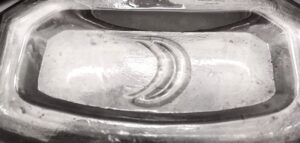
Crescent Moon logo on base of clear glass Druggist / Prescription bottle, used by Crescent Bottle Company. - Crescent moon logo (shown)………………..Crescent Bottle Company, McDonald, PA (1911-1916) and Hawthorne, PA (1916-c.1922). This mark is seen on the bases of handmade, clear druggist / pharmacy / prescription bottles with tooled lips, on both unmarked “generic” examples, as well as on personalized, lettered “slug plate” bottles from a number of druggists in Vermont and Massachusetts. (Thanks to VT bottle collector/specialist Barry Conolly for bringing this particular mark to my attention!) Also, this mark has also been reported on the bases of prescription bottles from St. Stephen, New Brunswick, Canada – thanks to Glen Phillips! (NOTE – added 5/17/2022: I’ve recently realized that druggist bottles bearing this mark have also been found from quite a few other states across the US. Some of these embossed druggist bottles include: Walkers’ Pharmacy, Schenectady, NY; Sommers Drug Stores, San Antonio, TX; Comstock-Moore Drug Co., Horse Cave, KY; Chubbuck Pharmacy, Freeport, NY; G. A. Walker & Co., Loogootee, IN; Pinehurst Pharmacy, Pinehurst, NC, and S.G. Wright, Lincoln, NE). There are surely many others out there, and if you know of one, please contact me!
- Crisa…………………….Crisa, now a division of Libbey Glass (acquired in 2006), with three factories located in Monterrey, Mexico. This is a large producer of table glassware such as tumblers, goblets, wine glasses, beer mugs and other glassware heavily used in restaurants, bars and other institutional settings. Much of the glassware marketed as “LIBBEY” in retail stores currently is actually made in Mexico by Crisa. They are also known for producing electrical telephone insulators, including CD 107 style units.
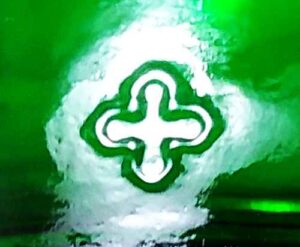
Cross mark used by VDL Company, Vergeze, Languedoc-Roussillon, France, as seen on emerald green Perrier Lime bottle with a date code of 2005. - Cross (double-lined cross, abstract design similar to a “fourchee cross” or “crosslet”, as shown above) ………………… seen on heel of Perrier mineral water bottles. This mark was used by VDL Company, Vergèze, Languedoc-Roussillon, France. VDL Co. produced all of the glass bottles for Perrier mineral water; later acquired by Owens-Illinois Inc., who now runs this operation effective August 1, 2011, and more recent Perrier bottles are now carrying the “O-I” mark on the heel. (I presume that the “O-I” mark was instituted very soon after the acquisition, but do not know exactly when the bottle molds were re-tooled with the mark of Owens-Illinois).
- Cross emblem (logo, hallmark, design, mark) on the base of pre-1900 containers………………see “X” entry.
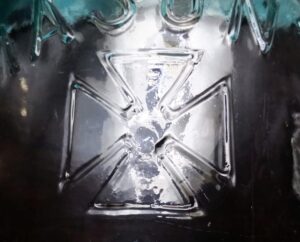
Maltese Cross emblem on front of fruit jar made by (or for) Hero Fruit Jar Company. - Cross (Maltese Cross emblem, above) ……………….. a Maltese cross logo has been used on many bottles and jars over the years, with various meanings, but this particular Maltese Cross (shown here) appears on the front or back of certain “Masons Patent Nov 30TH 1858” type fruit jars, and in this case it stands for the Hero Fruit Jar Company (also known as the Hero Glass Works for some time). Most commonly, the letters H, F, J, and Co. appear, each letter placed inside an “arm” of the cross, although in many cases the letters are very faint if not totally invisible. For a little more information on the Hero jars, please see my webpage here: MASON’S PATENT NOV 30TH 1858 Fruit Jars – Summary
- Crounse-Hinds …………………………………. Name seen embossed on glass traffic signal lighting lenses. Crounse-Hinds, manufacturer of traffic signal systems. Examples are actually products of, in most cases, Corning Glass Works or Kopp Glass Company. Here’s an interesting collector’s site with pics of a variety of vintage Crounse-Hinds traffic lights: http://www.trafficsignalmuseum.com/pages/maker-crousehinds.htm
- Crown logo (shown above) …………………. this seems to be a very recent glass manufacturer’s mark, which I believe to be from a glass company in Mexico. I haven’t identified the maker (yet) and am asking for help! If you know the name of the company, or if this is a “new” mark from a company I already have listed, please advise! This is on the heel of a green-aqua 12 oz. Topo Chico mineral water bottle, imported to the US from Mexico. It bears a 2019 date code (19) placed to the left of the trademark.
- Crownford China Co. ………………………… see this page.
- CRYSTO (on base of clear mouthblown druggist bottle that appears to date from the 1890-1915 time period)…………….. Unknown origin. This mark is presumably the brand name of a “generic” druggist/prescription bottle style, as used by an unidentified US bottle maker or perhaps marketed by a drug supplies distributor. From the scarcity of this mark, it was probably used for a very short time by an obscure company or in a very localized area.
- C. S. & Co…………………..see next entry.
- C. S. & Co. LTD (reported as ‘LD’ on some bottles) …………..Cannington, Shaw & Co. Limited, St. Helens, Lancashire, England (1875-1913)
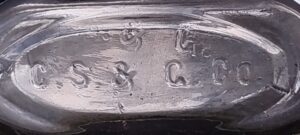
“C S & G Co” on base of Warranted Flask (photo courtesy of David Weaver) - C. S. & G. Co. …………….. almost certainly Cooper, Silica & Glass Company, Salem, Virginia (c. 1907-c. 1914). This mark was reported to me as seen on the lower heel of a “Huntsville Bottling Works” crown-top soda bottle. The mark has also been confirmed on the base of a full pint strap side “Warranted Flask” as reported by David Weaver.
- C S & L …………………………….see “S & L C”.
- C. V. No. 1 MILW………Chase Valley Glass Company, Milwaukee, Wisconsin (1880-1881). For more information and photos of many bottles made by this and related companies, see this page: Wisconsin Glass Gallery on MrBottles.com website
- C. V. No. 2 MILW………. Chase Valley Glass Company Factory 2, Milwaukee, WI (1880-1881)
- C. V. Co. No.2 MILW…………. same as above.
- C. V. G. CO MILW……………..Chase Valley Glass Company, Milwaukee, WI (1880-1881)
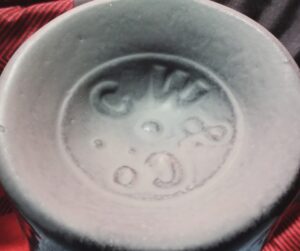
“C. W. & Co.” on base of Carson, Warren & Company black glass ale or wine bottle. (Glass surface was sprayed lightly with gray primer to bring out embossing, as the shiny black glass is very difficult to photograph clearly) - C. W. & Co. …………………. Carson, Warren & Company, Port Dundas, Glasgow, Scotland (c. 1847 – c. 1879). Initials are seen on bases of mouthblown black glass (very dark olive green or olive amber) ale and wine bottles, usually made in three-part molds. These bottles were evidently exported far and wide around the world as they have occasionally been found in such places as the Panama Canal, the Caribbean region, Australia, New Zealand, Canada and Asia, as well as the UK and the U.S. These initials had been a mystery for many years, but with help from the BRG (Bottle Research Group) and in particular from recent in-depth research by BRG member Bob Brown, this is virtually certain to be the correct user of the initials. The earliest reference found so far is from 1847 – The Journals of the House of Commons, Volume 102, page 184, in which an entry is found referring to “Carson, Warren and Company, Bottle Manufacturers” and David Carson and Timothy Warren as partners in that business firm. The physical factory itself was called the “Milton Glass Works”. The operation might have been under other business names at times during the period, but in any case it apparently failed in or about 1879. One example of a very rare black glass bottle has also been recorded (evidently found in Australia), marked with the full embossing “CARSON WARREN & CO. GLASGOW / MANUFACTURERS” on the base. Assuming that this works was in operation for at least 32 years, and made countless bottles over that period of time, it seems apparent that the great, great majority of its bottle production was unmarked. There is little doubt that many of the “generic” black glass bottles exported from Great Britain during the mid-19th century could be unmarked products of Carson, Warren & Company.
- C. W. & J. ………..Unknown. This mark might actually be “G W & J”, but I’m keeping this listing also, since the embossing is faint on some bottles and the “G” appears more like a “C” on at least one mold. Initials are seen on base of handmade black glass ale bottles of British origin. Lettering could possibly be “W. & J. G.”.
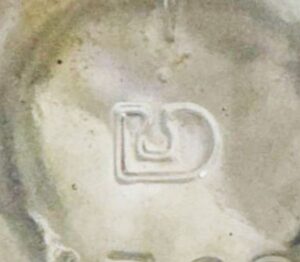
“Stylized D” trademark as seen on the base of a clear glass packer jar made by DOMGLAS, based in Montreal, Canada. (Photo courtesy of Kayla Verge). - D (stylized “D” logo, shown above)…………………. Domglas Ltd., (Domglas Inc. after 1978) business name used by Dominion Glass Company, based in Montreal, Canada after reorganization in 1976. This “weird D” or “notched capital D” mark was presumably used on glass containers from 1976 until 1989 when the firm was acquired by Consumers Packaging, Inc. Please see “D in a diamond” below on this page.
- D………………… Unidentified with certainty, but probably Davey & Moore, Ltd, Brimsdown, Middlesex (London), England (1805-1980). The “D” has been seen on the base of a handblown cobalt blue ribbed poison bottle, probably made in Great Britain. Toulouse (Bottle Makers and their Marks, 1971, page 153) attributed a “plain D” marking to Davey & Moore, and his information came from a contact who worked for Davey & Moore who claimed the “D” mark dated circa 1870-1900 and “D & M” mark dates from 1900 and later. Also, a similar mark was seen on the base of an amber strap-side flask that probably dates from sometime in the 1870-1890 period. However, that might be from an entirely unrelated glass company since it appears to be an American-made bottle. Also, see “D & M” entry.
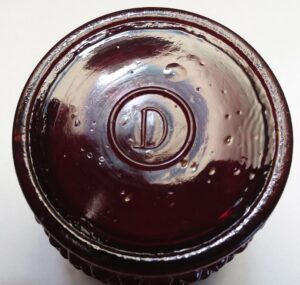
D inside a circle mark – on base of ruby red Hobnail votive candleholder. - D inside a circle (on the base of red “Hobnail” type votive candle holder or toothpick holder, shown here)…………………………. uncertain maker. Some votives carry this mark along with “U.S.A.”. I have seen auction listings (courtesy of Worthpoint) for at least 3 styles of votive candleholders in various glass colors: ruby red, cobalt blue, green, clear and a blue opaline (translucent light blue). Some of them were evidently part of hanging candle arrangements for religious purposes. I have read info online that attributed this logo as an early mark of Degenhart Glass Company, although that information may or may not be correct. The “D in a circle” also appears on the base of a blue carnival glass “Daisy and Button” sugar bowl and creamer set which has been strongly attributed to Degenhart. Most of Degenhart’s glassware (that was marked) carries their well-known “D inside a heart” logo (see below). If you have information that can confirm the correct identity of this logo, please write and let us know!
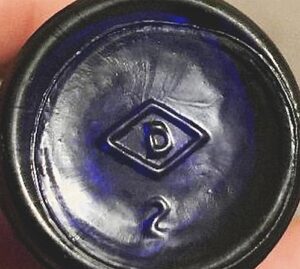
“D in a diamond” mark on base of cobalt blue Bromo-Seltzer bottle made by Dominion Glass Company. The “2” is a mold number. (Photo courtesy of Tyler Cazes) - D inside a diamond…………………… Dominion Glass Company, based in Pointe Ste Charles (Montreal), Quebec, Canada with other factory locations including Hamilton, Ontario; Wallaceburg, Ontario; Redcliff, Alberta; Burnaby, British Columbia; and Bramalea (in Brampton), Ontario, Canada. (1913- c. 1976). The “D within a diamond” mark was reportedly first used by Dominion in 1928 and continued to be used until about 1976. Dominion Glass started as Diamond Glass Company, Limited in 1890. Dominion became Domglas, Ltd. in 1976, Domglas Inc. in 1978, then was purchased by Consumers Packaging, Inc. in 1989, later Consumers Glass. (See “C in a triangle” for their mark). Consumers Glass was acquired by Owens-Illinois Canada Corporation in 2001 (now [2024] O-I Canada). Dominion was the largest glass container manufacturer in Canada, producing huge quantities of many types of bottles and jars over a long period of time. The mark used from 1913 to 1928 was evidently just a plain diamond with no letter inside (at least on their glass electrical insulators), but I don’t know if the mark used on their bottles followed the same appearance or timeline. See “Diamond logo” farther down on this page. For more information on Dominion Glass and the marks and codes they used, this link supplies a more in-depth discussion: Parks Canada document on Dominion Glass Company bottle mould numbers.
- D in a heart…………………… Degenhart Crystal Art Glass, Cambridge, Ohio (1947-1978). Seen on upscale handmade art and novelty glass such as salt cellars, toothpick holders, hen-on-nest dishes and figurines. The “D in a heart” emblem was used on much of their glass produced after 1964, and may be marked on the inside bottom instead of the outside of the base. Glassware made by Degenhart from 1947 to 1964 was evidently unmarked. Degenhart operation was sold in 1978 and the factory became Boyd’s Crystal Art Glass.
- D in a keystone……………Denver Glass Bottle Company, Denver, Colorado (1946-1951)
- D. B. & Co. Lt (or Ltd) ………………… Unidentified mark seen on “ten pin” style soda bottles that appear to be from Great Britain, perhaps dating from the 1890-1920 period.
- D. B. MFG. CO. ……………….almost certainly Dodson-Braun Manufacturing Company, St. Louis, Missouri (c.1898-1914+) This embossing was a mystery to me for a long while, and had been reported (by at least 3 separate contacts) as seen on a small, round, clear (or with slight amethyst tint) bottle that evidently held some type of food condiment. Recent info submitted by Chad Fitzgerald indicates Dodson-Braun as the source of this mark. D.B. Mfg Co., according to info published in Ketchup, Pickles, Sauces (1980) by Betty Zumwalt, was a food products firm, specializing in packaging pickles, as well as various relishes, sauces and other condiments.
- D.C.J. (on small radio strain insulators)…………. D. C. Jenkins Glass Company, Kokomo and Arcadia, Indiana (1906-1933)
- DD (stylized characters that look vaguely similar to two curved capital Ds facing each other, or two halves of a metal can in a curved formation) please see my entry on “American National Can Company”, on page one. This mark is seen on modern (1980s-1990s) soda bottles.
- Dean Foster & CO. ………….Dean, Foster & Company, Boston, Massachusetts (c. 1874-c.1911) and Chicago, Illinois (1883-1893). Seen on the base of a nurser bottle. See D.F.& CO.
- Decorama Inc. Dallas Texas…………. this lettering is seen embossed on glass stemmed votive “candle cups” or candle holders. This was evidently a relatively short-lived importing company specializing in decorative items for homes, and seems to have been in business in the very late 1960s or early/mid- 1970s. I have seen two candle holders with a “sawtooth” type design, one amber and the other a frosted ruby red glass. They are reminiscent of the candle holders marketed by FAROY, and were most likely made by an unidentified glass manufacturer in Taiwan or Hong Kong.
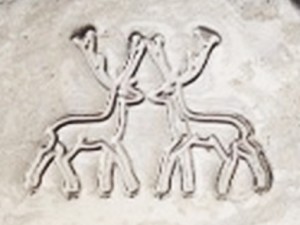
Two deer facing each other, logo used by Cerve S.p.A, Parma, Italy. (Photo courtesy of Diana Manganaro). - Deer (Two deer facing each other, shown)…………. Cerve S.p.A, Parma, Italy. (1953- to date). This company markets a wide variety of decorated glassware, especially tableware for household use, perfume bottles, etc. No information on the exact date range this mark was used, or if it is still being used. If you know, please write!
- Derrick (see “Oil Derrick” logo on page four).
- De S. G. Co. ……………………DeSteiger Glass Company, LaSalle, Illinois (1878-c.1889). This mark variation reported to me by Joe McAllister. (Also see “D. S. G. Co.”) It is likely that most, if not all, bottles with these and the much more common “D. S. G. Co.” initials were made during the 1878-1883 time period. The DeSteiger factory burned in 1883 but was evidently rebuilt and taken over by a new owner (Alfred A. Paddon) in 1884, who continued to run that factory under the DeSteiger name for several years- until about 1889. For more background information, see Bill Lockhart’s detailed article here: https://sha.org/bottle/pdffiles/DSGCo.pdf
- DES.PAT. (with several numbers, usually 5 or 6 digits)……………………..There are a number of bottles with this marking on the bottom, especially Owens-Illinois bottles mostly from the 1930s and 1940s. For instance, DES. PAT. 92148. This means “Bottle design was patented and assigned #92148 by the U.S. Patent and Trademark Office in Washington, DC.” A search online might bring up more information on some of these bottles, for example, searching the “Google Patents” database with that particular number shows that a patent was issued for that design in 1934. Keep in mind this does not mean that the bottle itself was made in that exact year, since a design may have been used for several years afterward, with many bottles produced for years after the patent was issued.
- D. F. & CO……….Dean, Foster & Company, Boston, Massachusetts (c.1874-c.1911) and Chicago, Illinois (1883-1893). This company evidently sold mostly medicinal/druggist bottles, and was probably a jobber rather than an actual bottle manufacturer, selling ware made by Sheldon-Foster and other glass companies. See “Dean Foster & Co.” entry, as well as “A.M.F.& CO” for a related mark.
- D. F. & D………..Dean, Foster & Dawley, Chicago, Illinois ( 1883-c. 1893) . See above entry and “Dean Foster & Co.” mark on this page.
- D. G. Co………….Diamond Glass Company, Royersford, PA (1885-1990).
- D H M Co…………..unknown. Seen on the base of handmade aqua bottle, possibly circa 1880-1910, that might have held pickles, olives or some other type of food product. The initials might stand for a distribution, processing or wholesale company of some type.
- Diamond (representation of a an actual cut diamond or other cut jewel/gemstone)……….. please see my listing under “Jewel” on page three.
- Diamond logo (on glass electrical insulators; no letters or numbers inside the diamond)………………Diamond Glass Company, Montreal, Quebec (1890- c. 1901); Diamond Flint Glass Company (c. 1901-1913), and successor Dominion Glass Company (1913-to c. 1928, after which time new insulator molds included a “D” placed inside the diamond). Note: some insulators carry the “plain diamond without letters inside” but are also marked with “DOMINION” so those would be products of the Dominion Glass Company and made after 1913. See Glass Insulator Manufacturers page.
- Diamond logo (on bottles; no letters or numbers inside the diamond)…………… in some cases, containers with this mark might be products of Diamond Glass Company, Montreal, Quebec (1890-1913) which became Dominion Glass Company and still later, Domglas. In a few instances, a plain diamond might indicate Illinois Glass Company (if the “I” in the “I inside a diamond” mark is invisible), BUT I believe the great majority of bottles with a plain diamond found in the United States are products of the Diamond Glass Company, Royersford, PA (1886-1990).
ADVERTISEMENT
- Diamond (or other geometric shapes, including square, oval, circle, keystone, triangle, etc) with a letter inside………. Please look for a relevant entry listed under the specific letter, although I do have a few entries that are also cross-referenced under the shape.
- Diamond with a “D” inside…………….Dominion Glass Company, Montreal, Quebec, Canada. Mark used from c. 1928 to at least 1976. See “D in a diamond” entry.
- Diamond with an “H” inside (seen on elegant tableware, stemware, high quality decorative glassware, not utilitarian container glass)……………….. A. H. Heisey Glass Company; please see “H inside a vertical diamond” entry on page two.
- Diamond I …………………….. Illinois Glass Company, Alton, Illinois (mark used circa 1915-1929).

“I inside a diamond” mark used by Illinois Glass Company, Alton, IL - Diamond with an “I” inside……………. Illinois Glass Company, Alton, Illinois. This mark is seen on huge numbers of machine-made bottles from the 1910s and 1920s. Please see “I within a Diamond” page.
- Diamond with letter & number(s) combination within it…………….Illinois Glass Company, Alton, IL, probably produced most, if not all, of these containers. Please see “I within a Diamond” page.
- Diamond with 2-, 3- or 4-digit number inside………Illinois Glass Company, Alton, IL (1873-1929). (Numbers found within a diamond on several types of bottles have been matched with catalog numbers found in Illinois Glass Co. bottle catalogs.) Exact period when this type of mark was used is uncertain, but probably sometime in the 1910-1920s period. Please also see “I within a Diamond” mark webpage. Other companies that might have produced some of the bottles found with these base marks include Diamond/Dominion Glass Company, Montreal, Quebec, Canada & other locations (later Domglas); and the Diamond Glass Company, Royersford, PA (1886-1990)
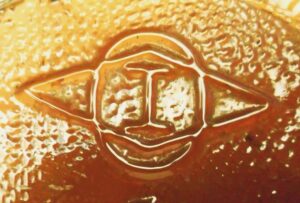
Owens-Illinois Glass Company trademark/logo – Diamond – Oval- I entwined. - Diamond entwined with/superimposed over an oval [letter O] with an “I” in center (shown)………………………. Owens-Illinois Glass Company (1929-to date – formerly with headquarters at Toledo, OH; now at Perrysburg, OH). This particular mark was used from 1929 to the mid-1950s, with a few bottles carrying the mark into the late 1950s. It is easily the most common glass manufacturer’s mark seen on containers made in the mid-twentieth century in the US, and the most plentiful mark on glass found at dump sites that date from the 1930s-1950s era. Please click on the link above for more in-depth information and illustrations of the marks used by Owens-Illinois.
- Diamond (with “wave” design inside, in upper half)……………… see Unidentified logo at the bottom of “Page 5“.
- Dillon G. Co……….Dillon Glass Company, plants at Converse, Indiana and Fairmount, IN (1889-1894)
- Dixon & Co. / Liverpool (embossed in a circular formation on base of black glass cylinder whiskey bottle with “PATENT” on shoulder)…………………Francis Dixon & Company, Liverpool, England (1845-c.1872). This mark may date between 1845 and about 1854. A brief mention of Francis Dixon & Company is made in this article about an old bottle works located at Thatts Heath, near Liverpool: https://www.lancashiretelegraph.co.uk/news/6028379.cradle-bottle-making/ . “F. Dixon & Co” is also listed as a bottle maker on page 174 in Statistics of British Commerce (Braithwaite Poole, 1852), with stats apparently collected in the 1849-1850 period. Francis Dixon was known in later years as Francis Dixon-Nuttall.
- DIXIE………………..Dixie Glass Company, Tallapoosa, Georgia (1898-c.1906 or later)
- D & M ……………………….Davey & Moore, Limited, Brimsdown, Middlesex (London), England (c. 1805- 1980). Julian Toulouse (Bottle Makers and their Marks, page 153) stated this mark dated after 1900, relying on information supplied to him from a contact (Mr. P.E.W. Harrison) who worked for Davey & Moore. The mark has been verified to exist on several bottles, including an aqua handmade round pickle bottle with crudely applied lip that was listed on ebay in 2021. That bottle looks older than 1900 (to me) but it may in fact be post- 1900, as Toulouse wrote that Davey & Moore continued to make handblown bottles even as late as 1925. Information about the early days of Davey & Moore are virtually nonexistent on the internet and I have found no concrete evidence to show any glass-making firm under the exact name “Davey & Moore” even existed until c. 1873, and that according to a brief mention on a .pdf file article indexed at the planning.islington.gov.uk site [URL was moved or deleted in recent years, and I can’t find it now], indicating that the glass company had just moved to a location on Albion Road (now 55 Balfe Street) and later (circa 1895-1897) moved to 33 Blundell Street, Caledonian Road. The Statistics of British Commerce (Braithwaite Poole, 1852) with stats probably collected in the 1849-1850 period, does not have a listing for this company. Davey & Moore engaged in the manufacture of “drain pipe (stoneware)” according to a business listing in J.A. Berly’s British, American and Continental Electrical Directory published in 1883. The glass making operation located on Lockfield Avenue in Brimsdown may have began much later, perhaps not until the 1930s. Davey & Moore was absorbed by United Glass Bottle Manufacturers, Ltd (UGB) in the 1960s or ’70s and eventually closed down in 1980. Also, see the “D” entry, said to be an earlier mark also used by Davey & Moore.
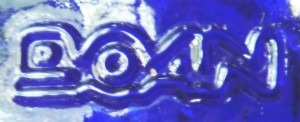
DOAN or DOVAN mark (Photo courtesy of Janell Bennett) - D & O ……………..Dodge & Olcott.
- DOAN (or possibly “DOVAN”), as shown in pic, right ………..embossed mark seen on base of decorative cobalt blue bottle with raised figures of Greek or Roman nudes (mythological gods) along with vertical columns/pillars. Unknown origin. If you have information on the source of this mark, please write!
- D.O.C. ………………… D. O. Cunningham / D. O. Cunningham Glass Company, Pittsburgh, Pennsylvania (1880-c.1938). This glass company was owned and operated by Dominick O. Cunningham (born 1834) until his death in 1911. A prolific producer of soda and beer bottles, especially Hutchinson-style sodas (“hutches”) as well as crown-top bottles after the mid-1890s. The company produced both mouthblown and machine-made bottles. The initials are often found embossed on the lower heel of the bottle along with a mold number. For some background information on this operation and other Cunningham-related glass companies, see Jay Hawkins’ reference book “Glasshouses and Glass Manufacturers of the Pittsburgh Region 1795-1910“. See “C & CO” and “C & CO LIM”.
- Dominion………………..Dominion Glass Company (now Domglas), Canada. Seen on electrical insulators. See “D in a diamond” entry, and page on Glass insulator manufacturers.
- Do-Ray………….DoRay (or Doray) Lamp Company, Chicago, Illinois. Mark seen embossed on glass automobile tail light lenses, traffic signal lenses, railroad lenses and similar items. No information on dates of operation. Circa 1950s-1960s?
- Dots (raised dots or bumps seen on the base of certain types of older bottles)…………………… On some older bottles, primarily handmade examples, several raised dots or bumps are found on the base. In most cases, they served the purpose of a mold number — merely a unique “mark” that identified a particular mold in a glass factory, especially when a number of identical molds were being used to make a certain type of container. The dots may be arranged in various orientations or geometric patterns. They are seen on case gins, snuff jars, ale, beer and soda bottles, and some older fruit jars and other bottles. In the case of snuff jars, myths have circulated for decades among bottle collectors that the dots seen on the bases of those jars indicate the strength of the snuff, or are date codes. This is not true, as explained in an article published in Old Bottle Magazine, February 1972 issue, page 10. (The number of dots – and their exact orientation – merely identified bottle molds on the automatic machine). Also, please see my entries under “X”, “Star” as well as my page on Numbers seen on the Bottoms of Glass Bottles. Also, this is not in reference to a single raised bump often seen in the very center of the base – that is called a mamelon). (Note: These types of marks on old handmade bottles are not to be confused with an unrelated subject: the series of raised dots, similar to braille, seen along the lower heels of modern-day beverage bottles. This link points to information on a patent involving a sophisticated system of quality control at the factory) : https://patents.google.com/patent/US5028769A/en
- D. P. B. ……………Initials as reported on base of crown-lip, light green-aqua beer bottle, circa 1900-1920. Probably stands for the Deer Park Brewing Company, Port Jervis, New York. Thanks to Michael Mackey for reporting this mark.
- DPS (D P S) inside a diamond……………….. Unknown manufacturer – the initials might stand for a glassmaker, or that of a distributor or importing company. The glass mostly likely is made in Asia – possibly in Taiwan, China, India, Malaysia or Indonesia?? This marking is seen on the base of modern decor bottles, jars and vases of various designs. They appear to be of fairly recent manufacture. One type of bottle is also marked “JAR DOT” on the base. The “Jar Dot” bottles have a screw-type lip, and are covered with vertical rows of “raised dots / bumps” or hobnails. They have been seen in light olive green, honey amber, red, green, purple, and other colors. The color appears to be (in most cases) a surface stain applied over clear glass. The clear glass may be seen by looking up through the bottom. If you have information on the meaning of this mark, please let us know!
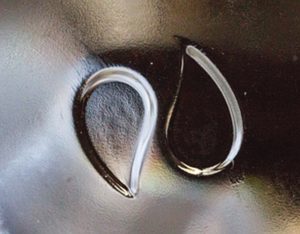
Logo of two teardrops / water drops – Pasabahce, Turkey. (Photo courtesy of Dan Goorevitch) - Drops/droplets (Two teardrops or drops of water, reminiscent of the Chinese “Yin/Yang” symbol)……………….. this mark indicates the brand Paşabahçe (pronounced PAH-shah-BAH-cheh), one of several brands owned by Şişecam, (pronounced SHEE-shee-jahm), based in Istanbul, Turkey (1935-to date). The Paşabahçe Glass Factory was started at Beykoz, Istanbul, Turkey in 1935. The operation has grown over the years, now with a number of factory locations in Turkey as well as Russia, Bulgaria and Egypt. Şişecam produces many types and designs of glassware for home, commercial and restaurant use under the Paşabahçe brand. Their products are exported to many countries around the world, being sold through a number of stores/outlets/distributors in the US including Circleville, Old Time Pottery and Le’raze. I don’t know what year this particular mark was introduced (please tell me if you know!). Some of their glassware bears a “P” on the bottom. This page has more background on the history of this operation:
https://www.sisecam.com.tr/en/about-us/history - Dr. W. B. Caldwell’s, Monticello, Illinois……………. See “Caldwell’s” webpage.
- Dr. Y.Y. B. Caldwell’s, Monticello, Illinois…………..See “Caldwell’s” webpage.
- D. S. G. Co…………..DeSteiger Glass Company, LaSalle, Illinois (1878-c.1889). See the “De S. G Co” entry on this page for more information.
- DURAGLAS…………………Owens Illinois Glass Company, Toledo, Ohio (1929-to date). For more information please check out my page on the Duraglas trademark. This trademark was used by Owens-Illinois Glass Company beginning in 1940. Most glass containers with the Duraglas brand embossing appear to date from the 1940s-1970s. Click here for more info on Owens-Illinois Glass Company. Other marks used by Owens-Illinois include OWENS, LOWEX and KIMBLE as well as many others.
- Dyottville Glassworks Phila (on base of cylinder whiskey bottle)……………… see next entry.
- Dyottville Glass Works Philad’a. ……………………..Dyottville Glass Works, Philadelphia, Pennsylvania (c. 1833-c. 1899). This operation, located in the suburb of Kensington in Philadelphia, had long been known as Kensington Glass Works (c. 1816 to 1833). Dr. Thomas W. Dyott (1771-1861) was heavily involved in the works early on, and by about 1821 was part, if not full, owner and manager of the operation. Beginning in the early 1820s and possibly into the early 1830s a number of flasks were made that bear the marking “KENSINGTON GLASS WORKS PHILADELPHIA” and / or “T. W. D.” on them. (See “Kensington Glass Works” entry on page three). Dyott gradually expanded the works and implemented the building of an extensive complex or small “town” around the glassworks which became known as “Dyottville”, with the factory itself – consisting of several separate factory buildings and accompanying outbuildings – being known as the Dyottville Glass Works – by around 1833 if not before. Dyott filed for bankruptcy in 1838 and the works were shut down for some period of time between 1839 and 1842, later to be reopened, continuing on and off under several other operating firms until about 1899. (The exact ending year has not been determined with certainty).
The Dyottville Glass Works produced large numbers of pictorial / historical flasks (such as some of the Washington/Taylor “The Father of His Country” flasks, in particular GI-37 and GI-38 (in the McKearin figured flask classification system) and those could date from the late 1840s and possibly into the early or mid-1850s. (Note – reproductions of those particular flasks have been made in modern times by other glass makers including Clevenger Brothers – consult knowledgeable flask experts to determine if a particular example is a real Dyottville flask or a later copy). Other bottles found with the Dyottville embossing include a large number of lettered blob top soda and porter style bottles that probably date mostly from the 1850s-1860s period, as well as cylinder whiskey bottles that likely also date from that general time period and some possibly as late as the 1870s or 1880s. Some of the cylinder whiskies are lettered “PHILA” instead of “PHILAD’A”. Most of the Dyottville glass production over the many years it was in business, under several owners, was not marked. For more information check out this Lockhart article about Dyottville : https://sha.org/bottle/pdffiles/Dyottville.pdf
[ A – B ] [ C – D ] [ E – L ] [ M – R ] [ S – Z ]
Please click here to go to my HOME PAGE.
ADVERTISEMENT

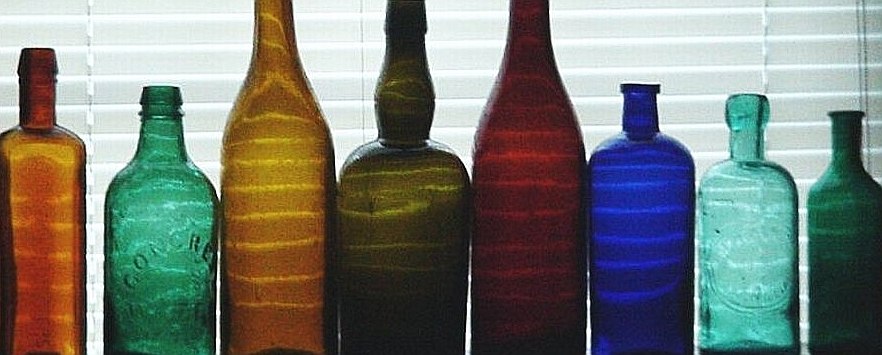
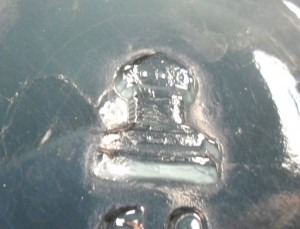
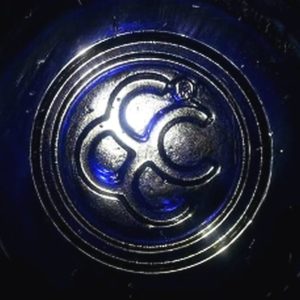

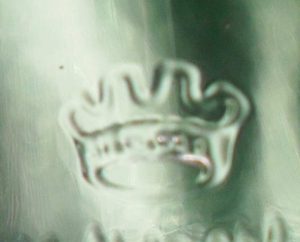


I have purchased 16 oz. drinking glasses from Crate & Barrel a couple times in a 20 year span. Same “Rings Cooler” style and the older ones have the ‘”drops” marking while the newer have the “P”. So it appears the are from the same Turkey factory or at least company. I half-thought I remember them posting that they were made in Spain or Portugal.
They still carry the line at Crate & Barrel but now the web site says they are made in Egypt. I’ll have to check the mark if I ever get into the store or order more to see if they have another mark on them now.
Tim, thank you for the information. I assume the “P” you see on these glasses is “plain”, not inside a circle. Right?
Thanks and take care,
David
Hi, there the “WVB” base you have is from “west Virginia bottling co”. I have a full bottle I can send pictures of, if interested email me .
Hi Taylor,
I sent you an email but have not received a reply. Can you please check your spam folders?
Thank you, David
Hello, I found a small glass (what looks like a medicine bottle) bottle in a stream while I was fishing with “HBD Co” on the bottom. I can’t find any information on this bottle. Could you help?
Mike, I don’t know what “HBD Co” stands for. Readers, if anyone finds out, please post here and let us know!
Thanks for your post,
David
https://www.tace.com/i/32136.html. I have this 1940’s round perfume bottle with a fish and “ocean wave” topper. It is marked “REC DES US PAT OFFICE”. Could you possibly provide me any info about it? Yvette.
Hi Yvette,
I saw the picture of your bottle on that site. The marking (I believe) is probably “REG [not C] DES US PAT OFFICE” which basically means “Registered Design in the United States Patent Office records”
The problem here is: we would need to know the exact patent number that was issued for that bottle design. Every patent design is assigned a number, such as 945630 or whatever. Without a patent number (or a specific date), it is harder to find information on an item that was patented. I tried searching the GOOGLE PATENTS website with keywords such as “glass perfume bottle fish” (without quotes) but without success……there were thousands of search results and I only had time to go through a few of them; none of them were relevant. I am sure that bottle is listed on the site somewhere… but it may be hard to find it.
Sorry I can’t be of much help here. I am happy to post your query here on the site, so perhaps eventually someone else can comment on your bottle. Maybe someone out there will have good info for us!!
Thank you and take care!
David
Designed by ALFRED A. FLASTER c. 1942. distributed by the Theon Company of New York. The Company was established in 1935 by Marcella Flaster.
The base of the bottle represents waves and bubbles and the glass stopper is a fish. Bottle is in good condition. It measures 6 1/2 inches tall and is 3 1/2 inches across at its widest point. The bottom of the bottle is marked DES REG US PAT OFFICE.
I have a 1 qt jar that simply has MASON across the middle of it. On the the heel is a 13 with a very square G and a mirror image C underneath. On the bottom is a 28 with a circle around it, the letter “A” and then the number 75. There are 3 glass bumps on the bottom with one being under the 75 and the other 2 spaced farther apart. The glass itself has almost a handblown look to it, almost a hammered appearance. I read the page on Glass Container Corporation and that sounds like what I have, but I was hoping you could help with a date range. It sounds like that may be impossible atm, but thought I would ask. I’ll be more than happy to send you pictures if you like. Thanks for any help you might be able to provide.
I have an old coke bottle with no deposit no return on it. The mark on the bottom is what looks to be like s crown over shield . Does anyone have an idea what this bottle is from
Hello – I have a bottle that was found during a grave dig at the cemetery. I believe it was manufactured ty Diamond Glass Company – on the bottom of the bottle there is a horizontal diamond (nothing embossed on the inside), and a number 7 to the left of the diamond and a number 47 to the right. From what I read about Diamond Glass Company, the 47 may be the year of manufacture. No idea what the 7 indicates. Toward the top of the bottle, there is an embossed V in a circle. It does have a threaded top, as if there may have been a cap.The outside diameter of the “lid” area is .675″, while the actual hole opening is about 3.16″.
Any clue as to the meaning of the “V”?
Thanks.
Cindy Swagler
Cindy, I don’t know what the “V” signifies. The “47” probably does stand for the year 1947.
David
Hi-
Live in the Florida Keys and am finding lots of older bottles on nearby vacant properties post Hurricane Irma. I love your site as it is helping me learn the history of these bottles- many from the 1920’s to present. Thanks for the detailed information you provide!
Thanks a lot for the kind words! I’m glad the site has been helpful ~
Take care, David
Visited your site for the second time. Might have commented quite some time ago. Was the last member of the family to work for Reed Glass. (Grandfather) Also put in time at Castle Hanson. My father was production manager for Reed. Great memories and photos, plus an aerial view of the Maple St. plant in Rochester taken in early 50s. Still wander around the old property. Have a small collection of Reed ware.
Good work on your site!!
Hi Rick,
Thanks very much for your kind comments about the site!
David
Found a piece on the beach that I just haven’t been able to match with anything online.
The symbols on the piece read as follows (except the diamond is a pentagon):
∐ · ♢ 8
(Upside down Pi, Dot, Pentagon pointing right, 8)
I’ll attach a link to a picture of it if you wanna check it out.
Cheers.
https://imgur.com/qTrJAM8
Hi TJ, I’m not familiar with that “squared U” symbol which I assume is the glass maker mark, although I would guess the bottle (it is a piece of) was made somewhere in Europe.
Sorry I cannot ID the origin.
David
Found a bottle small with D,P.C. inside a diamond. What does it stand for what was it used for.
Evelyn,
I’m not familiar withe the mark you describe. Readers?
David
I have a cobalt bottle with a screw top (top missing) 1 1/2 inches tall. It has a double triangle on the bottom. Can anyone ID it for me? Thanks
Elaine, you have found a VICKS VAPORUB menthol salve jar. Many slightly different variants have been made over the years. I am not sure of the date range for the “two triangles on the bottom” version.
David
I have a very unusual Dr Pepper bottle. .the bottom has Oklahoma City Ponca City Tulsa Dr. Pepper bot. co 61/2 fl oz. On the lower part of the neck–not the bottle body–are four circles, one on each side, each with a single letter D P B C. I cannot find any information on the dating of this bottle–any idea?
What a wonderful service you’ve performed here! Thanks so much for your obvious dedication.
Thank you James!
~David
Lulu, the initials stand for John Wyeth & Brother, Philadelphia, a large pharmaceutical firm, but the actual glass maker is not known to me. I would guess (guess!) some of the Wyeth bottles were made by Whitall Tatum Company, as they were (relatively) nearby in New Jersey and made a lot of bottles for Philadelphia-area firms. You might find more info on their products and history with an internet search on Wyeth.
David
I found the bottom of a bottle on the beach. Letters seem to be O.CH.O. does anyone know what this might be?
Sir. being an Amateur myself I find all kinds of artifacts from native American to Spanish etc, on day my children were on the shore of the st john/s river at the location of the lower store indian trading post chasing minnows, I looked down and found a lid of the brass variety i assume of considerable age, with co&co markings, would you know the type of bottle it came off of by chance or apprx, age, just have history in my blood and am curious, Sincerely, James d Hubner
PS You can see the lid on my web site or I could send you a few pics if you would care for me to do so. Thanks in advance.
James, sorry I have no info on the lid. The mark “co & co” doesn’t make sense to me so I am wondering if you mis-read it.
David
I was the last member of the family to work at Reed Glass in Rochester, NY. It was a summer job and It was shift work in the test lab in 1956, the year the company went bankrupt. My grandfather was Arthur Reed, and I guess he wanted me to experience the work before they shut the doors. What a fantastic place: noise,smoke,heat and a great cast of characters. All three tanks were fired with coal gas, and I can still see the men working the hot end. Years later, I videoed the destruction of Leone Industries when they shut down. Some of the old buildings are still on the property, as I still detour to 860 Maple St.if I’m close by.
Hi Rick, and thank you very much for your post! I appreciate your input.
~David
I have a small square glass bowl with what looks like three candles on the bottom. Does anyone know anything about this mark? Thanks!
If it’s less than 40 years old then maybe it’s a Partylite product but they use stickers now. I don’t know if they’ve ever had their logo molded in glass.
Is there any info on a logo that details a small capital G and M inside a large Q. Its under a old coke bottle with the numbers 15Q703
Hadz, I’m not familiar with it, but perhaps a reader has more information.
David
Cheers Dave, Happy Days 🙂
I live in Boise, Idaho and have ditch irrigation in my yard(water from the Boise River). This spring I found a bottle floating in my underground ditch, with cap still on. It has a two-headed “thunderbird” type emboss on the shoulder, LIQUOR BOTTLE in caps on the bottom, the numbers 7059 above the liquor bottle writing, D-126 below, and what looks like a triangular trademark that may read YC within the triangle. The numbers 79 and 2 appear above the liquor bottle writing and L 9 below. I am not expecting that this is valuable, but I am curious as to how old it may be. It is discolored from being in water, but otherwise in good shape. I have been unable to find out anything about it from local antique shops. Any clues from anyone? Isabel
Hi Isabel,
I just realized I approved your post from June of 2016 but did not answer it. Re-reading your question, I suspect the triangle mark you are describing MIGHT be one of the marks used by Thatcher Glass Manufacturing Company. Can you check my page on that glassmaker and see if the mark resembles that triangular mark with the two “angular” letters “T” and “G” placed to the lower left and right? The “79” is likely a date code for 1979. “2” (in this case) is probably the Liquor Bottle Permit Number assigned to Thatcher.
Best regards,
David
David-A mistake on the number on the bottom of the Liquor Bottle I wrote about finding in my irrigation ditch in Boise; it should be 7053. I cannot decipher the triangle below, but it may be Y and D in an inverted triangle. Thanks for any info you can provide.
Isabel, can you send a picture of the mark to my email address, which is listed at the right-hand bottom corner of this page.
David
Hi I have a wine glass that is fairly new that I had a interest in, I found a logo or mark on the bottom of it with two droplets next to each other I was just wondering what companie made it.
James, I’m not familiar with the logo you describe, and I don’t know who the manufacturer is, but have posted your query here.
Perhaps someone who knows more about it will land on this site and answer your question.
Take care, David
Hi James, I found your comment when I was researching the same makers mark. I thought it might interest you to know that I’ve made an identification: Paşabahçe. Enjoy!
Hi SavvyGlass,
Thanks for your post and reply. Can you pass on more info on the mark in question, and where it is linked to Pasabahce? Just trying to find out more info on this mark. From scanning a number of ebay auctions, I found out that Pasabahce (Paşabahçe) of Turkey usually marks the bases of their tumblers and other glassware with a “P” mark. Any additional info is appreciated!
Best regards,
David
I have wine glasses with 2 water droplets at the base as well, just as James posted on May 23, 2016. I have not found any information on them.
I found a bottle brown glass 1 inch square x 2.5 inches high. On the bottom there is a diamond shape stamped in glass and #7 next to it. It was buried under six feet of untouched dirt in Charlotte NC. Is there any value to it.
Hi Byron,
It sounds like a bottle made by Illinois Glass Company of Alton, IL. (Please see my page on that company). Because Illinois Glass made such huge numbers of bottles of many types, I doubt if it has much value to collectors at the present time. Maybe a dollar. It sounds like it might be an iodine or merthiolate bottle or something similar. Still, a nice item to find, and an authentic example of older American MADE IN USA glass! It likely dates between 1915 and 1929. Hope this will help.
~David
I found a sea glass bottle bottom that I’m having a pretty tough time identifying. Going around in a circle, it read as follows. There is a “24” then “C.H.C & .S”, but below the dot after the first “C” is a second less-embossed dot. It’s about 2 1/2″ across, the walls of the bottle are circular and pretty thick. The color appears to be forest green. Can anyone help me identify the manufacturer and/or age of this bottle piece?
Matt, I’m not familiar with those initials. Perhaps a reader will know. I suspect it could be the initials of a bottling company, and the “S” might stand for “Sons” or “Son”. Can you send a picture of the base to my email address (shown at the bottom right of any page on this site).
Best regards,
David
Hey guys I also have a bottle that is very similar I think. Mine show C.H.C & . S then the number 24. I emailed David the pictures I took.
**Correction the number 23 **
Hi Emily,
Your bottle with the “C.H.C & S” mark is definitely a product of Great Britain (United Kingdom) and probably dates from sometime in the 1870-1900 period. It is a dark green, “3 piece mold” ale bottle with applied lip. The “look” is characteristic of many such bottles from other glassmakers in Britain during that general time period, such as those marked with the initials “J.K.& S. (John Kilner & Sons), “N & CO” (Nuttall & Company), “J. L. & Co” (John Lumb & Company), “C. S. & Co” (Cannington, Shaw & Company) and others including some with unidentified marks. I don’t know what the initials stand for, but I wouldn’t be surprised if the information is out there somewhere. Readers??
Thanks, David
Have 8 glasses with symbol H over small a. In summer cottage since about 1950 that I know for sure. Maybe earlier. Anyone know details on them.?
A simple google search with “H over a glass mark” brings up the name of the company in question………….. Hazel Atlas Glass Company. Please see my page on that glassmaker. However, to be honest Hazel-Atlas made TREMENDOUS quantities of bottles, jars, tableware (drinking glasses, mugs, bowls, vases, candy dishes, etc) over a period of several decades, and it may be difficult to find detailed info on a particular type of glass. You might try some searching on Google Images with keywords to try and find the pattern name or approximate age. Also try searching ebay.com and type in keywords in their item “Search” box which best describe the glasses you have. Sometimes this will work in bringing up similar glassware……..although sellers often don’t know what they have either.
Best regards, David
Either I’m just really blind (I’m a Bear, in which species has poor vision) or you’re not displaying the bottle maker I have on one I pulled out of a ’50s/’60s (mainly that era) dump. The base says, “C. P. CO. / 12.” Forgive me if it’s in there, I just cannot see it and I’ve scrolled several times. I’m unsure of what it was for. It’s only a few inches tall, narrow, and has twists in the neck. Screw-top.
Yogi, I’m not familar with any glass company name with C. P. CO. as the initials. It probably stands for some other type of firm or business.
David
I found a 12″ high hexagon wine bottle with a cloth cork, says The Robinson wine corp limited, on the bottom is a D in a diamond
Does any one know the age or value of this?
I have a pair of footed glass inkwells with hinged, brass lids. One of the bottles has the mark of a stylized H over a G. Does anyone know the meaning of this mark?